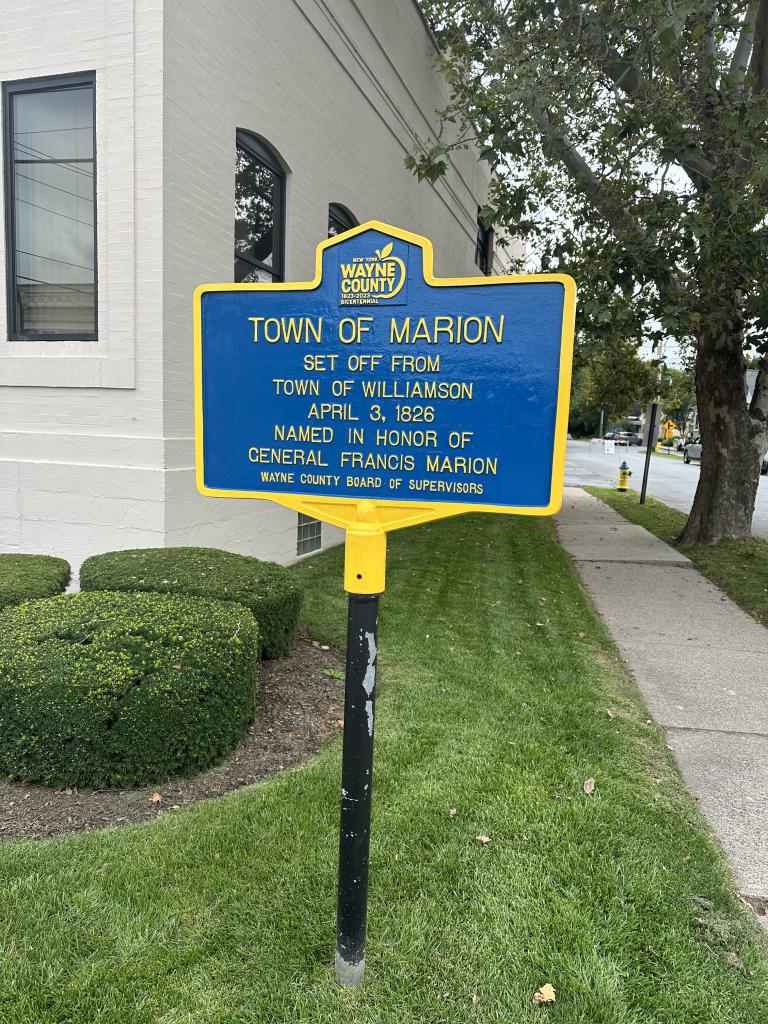If you find errors OR have additional information about this site, please send a message to contact@waynehistorians.org.
Marion Founding Historic Marker Bicentennial Edition
| Historic Site #: | 07-005 (Exists) Type: B2 | Town: | Marion | ||
| Site Name: | Marion Founding Historic Marker Bicentennial Edition | GPS Coordinates: | 43.143051, -77.189066 | ||
| Address: | E. side Main St at 4 corners | ||||
| Description: | |||||
Marion settled in 1795-6 by pioneers from Rhode Island and Massachusetts Legally established by the New York State Legislature as the town of Winchester on April 18, 1825 (48th session Chap. CCX) but this law was effective on April 3, 1826. The New York State Legislature passed an act renaming it Marion on April 15,1826 after Francis Marion, Revolutionary War hero (Chap. 213) The revised marker was dedicated on Sept. 9, 2023 and provided by the Wayne County Board of Supervisors as part of the Bicentennial celebration of Wayne County. | |||||
 |
| September 9, 2023 |
| Historic narrative: | |||||
MARION - from the D.A.R. pamphlet published for the dedication on July 4, 1934 as written by Mrs. S. B. Clark "Up to 1802 formed a part of the town of Sodus, but in that year the tract comprising Marion, Walworth, Ontario and Williamson was formed into a town called Williamson. In 1825 the town of Winchester was formed (see above for correct date - CD, historian) and on April 15, 1826, the name was changed to Marion, in honor of General Marion. The township is nearly square, covering an area of 17,391 acres. Prior to 1810 the Upper Corners was the most important part of the village and for a number of years held its place as equal to the Lower Corners. In 1825 there were at the Upper Corners, about ten homes and in Marion village eleven houses, seven on the east side of the street and four on the west side of Main Street. At the Upper Corners there was a physician, a blacksmith shop, a small cabinet shop. At Marion village, a tavern and a store, a grist mill, ashery, distillery, school, blacksmith shop and a post office. The first marriage in town was that of Elizabeth Howell and David Sherman in 1796. Corn and grain were the first crops grown, but early in the history of the town began the growing of fruit, especially apples. John Smith came from New Jersey in 1807 bringing apple seeds and soon started a nursery. The first annual town meeting was held April 4, 1826. The following officers were selected; Supervisor, Seth Eddy; Town Clerk, Samuel Moore; Assessors - Isaac R. Sanford, David Eddy and Thomas Lakey; Collector, Samuel Ball; Overseers of the Poor - Samuel Delano and Joseph Caldwell; Highway Commissioners - Reuben Adams, Peter Eddy and Benjamin Mason; Constables - Samuel Ball and Jeremiah Angell; Commissioners of Common Schools - Joseph Caldwell, Thomas Lakey and Samuel Moore; Inspectors of Common Schools - Jesse Mason, Homer Adams and James Smith." | |||||
